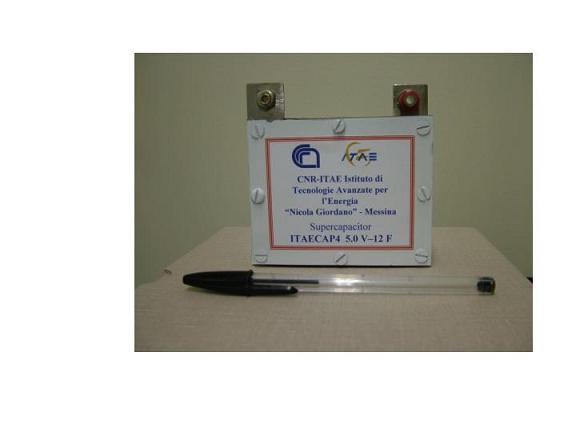Supercapacitors are electrochemical devices which can be efficiently used together with primary electric current generators in mobile applications. They are characterized in supplying high electric power for short times (seconds), while the electrical generators (batteries and fuel cells) are suitable in delivering electric current for longer times at constant load. Thus supercapacitors, may be advantageously used, together with batteries and fuel cells, in the electric vehicles, in the transceivers, in electronic devices, in the UPSs, for which variable demands of power are required during their operations. Recent results, reported in international scientific papers, regarding working tests carried out on electric vehicles supplied with integrated electrical systems, i.e. supercapacitor/fuel cell and supercapacitor/battery, have evidenced that the performances in terms of acceleration and autonomy (distance covered) for these vehicles are remarkably better than those obtained by electric vehicles which use only fuel cells or only batteries. Supercapacitors (SC) are electrochemical devices able to store and deliver high power electricity for numerous repeated cycles (million of cycles) without any appreciable decay in performances. A supercapacitor SC is formed from two electrodes and an electrolyte interposed between them. The electrical charges are stored at the electrode/electrolyte interface in a physical way and without redox chemical reactions. As the physical process of charge/discharge produces low amount of electric charges at the interfaces, a material of high surface is needed to achieve high energy and power density. The SCs are of various types, different for kind of electrode or electrolyte. Those mainly studied are using electrodes based on high surface area carbons and liquid electrolytes (in aqueous or organic solutions).
At the Institute CNR-ITAE of Messina it is in course of development a research activity, financed by Consiglio Nazionale delle Ricerche, oriented to the development and to realization of a supercapacitor that for the typology can be considered a completely innovative system. It consists of all solid-state components (electrodes and polymer electrolyte), being also the electrolyte formed from a solid polymer ionic conductor. Such type of SC has been named all solid-state supercapacitors. Mainly, the research activities in this field were addressed to the development of electrodes and to the testing of small scale supercapacitors. For the electrode development, recently we have synthesized new nanostructured carbon materials of high surface area, in which the final material has a ordered structure (hexagonal-type, P6mm) and pore size (mesopores) of well tailored diameter (see Fig.1). These materials, at difference of activated carbon materials (which are amorphous and with large pore size distribution), generally used in traditional supercapacitors, exhibit higher specific capacitance. Recent, results have evidenced that the performances of our supercapacitors, in terms of specific power, capacitance and lifetime are equivalent or even better than those of conventional devices. As an example, specific capacities of 130÷160 F/g (referred the weight of carbon material for electrode) have been reached with nanostructured mesoporous carbons in solid-state supercapacitors, whereas cycling tests, carried out for more than 20.000 cycles, have evidenced a performance variation of few units of percentage.
Regarding the activity for the development of small scale full supercapacitors, in the last two years we have realized different prototypes of solid-state supercapacitors with interesting performances (see also web page http://it.geocities.com/nanocapacitors/). Recently, the design, fabrication and evaluation of a prototype of supercapacitor has been published in an important electrochemical journal (paper by P. Staiti, F. Lufrano, Journal of the Electrochemical Society, 152 A617-A621 (2005)). In the paper, it was shown that our prototype of supercapacitor is able to give specific capacitance of 114 F/g (referred the weight of carbon material for electrode) and a power density of 1.4 kW/l. These results are equivalent of those obtained with better commercial supercapacitors. Another prototype having capacitance 12 F at 5 V was realised in planar form and the results are still unpublished (Fig. 3).
Vedi anche:
Immagini:

